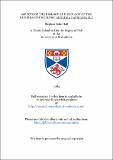Files in this item
Aspects of the biology and ecology of the nudibranch mollusc 'Aeolidia papillosa (L.)'
Item metadata
| dc.contributor.advisor | Todd, Christopher David | |
| dc.contributor.author | Hall, Stephen John | |
| dc.coverage.spatial | 137 p. | en_US |
| dc.date.accessioned | 2018-06-26T14:54:38Z | |
| dc.date.available | 2018-06-26T14:54:38Z | |
| dc.date.issued | 1984 | |
| dc.identifier.uri | https://hdl.handle.net/10023/14629 | |
| dc.description.abstract | In this study particular attention has been paid to the foraging biology and ecology of Aeolidia papillosa (L.); an anemone-eating nudibranch mollusc. 'Prey-value', derived in its current biological sense from optimal foraging models, is expected to be an important determinant of prey-selection behaviour. In the present study 'prey-values', or more specifically, food or tissue-values (because intact anemones were not used in the analyses), have been investigated for a range of anemone species. Analysis of the biochemical composition of anemone tissues and their consumption and assimilation by nudibranchs did not reveal any marked interspecific differences. S.troglodytes, however, is indicated as being somewhat different from the other species studied, possibly being assimilated more efficiently and consumed at a faster rate. These factors, in conjunction with the strong preferences shown for S.troglodytes in switching experiments and the apparent preponderance of field associations with this species, do Indicate that S.troglodytes may be a more valuable food item for A.papillosa. Analysis of the canposite estimates of fitness (growth and reproduction), however, did not reveal any contrasts in performance which could be related to diet. This was almost certainly a result of the marked variability in the performance of nudibranchs within each diet group obscuring any dietary effects which may have obtained. In the latter part of this study a series of behavioural experiments were conducted which investigated specific aspects of prey-selection behaviour. Using a variety of multiple-prey species choice experiments, data have been collected which show the effects of previous dietary experience on prey-species selection. The results of these experiments suggest that at least some of the contradictions in previous reports of prey-species preference by A.papillosa may be accounted for by "ingestive conditioning". "Ingestive conditioning" concerns the modification of a predator's behaviour such that it continues to choose that prey species which it has most recently or most frequently encountered. Such alterations of prey preference may exert considerable effects on the control of local anemone prey populations and their relative abundances. A variant of this experiment was ccmpleted during a five week investigation at the Friday Harbor Marine Laboratories, University of Washington, in the summer of 1982. Experiments showed that ingestive conditioning occurs for both U.K. and N.W Pacific A.papillosa. However, the modified experimental design used in Friday Harbor, and in corroborative experiments in St Andrews, also indicate that there is a significant "carry-over" effect from the previous conditioning diet. In the light of these results it was predicted that A.papillosa might exhibit frequency-dependent (i.e. switching) prey selection. Experiments undertaken to test this hypothesis were unable to demonstrate such behaviour due to persistent preference for one particular prey species. Field observations of A.papillosa-anemone associations are discussed in relation to the laboratory investigations. | en_US |
| dc.language.iso | en | en_US |
| dc.publisher | University of St Andrews | |
| dc.subject.lcc | QL430.5A45H2 | en |
| dc.subject.lcsh | Nudibranchia | en |
| dc.title | Aspects of the biology and ecology of the nudibranch mollusc 'Aeolidia papillosa (L.)' | en_US |
| dc.type | Thesis | en_US |
| dc.contributor.sponsor | Science and Engineering Research Council (SERC) | en_US |
| dc.contributor.sponsor | Russell Trust | en_US |
| dc.type.qualificationlevel | Doctoral | en_US |
| dc.type.qualificationname | PhD Doctor of Philosophy | en_US |
| dc.publisher.institution | The University of St Andrews | en_US |
This item appears in the following Collection(s)
Items in the St Andrews Research Repository are protected by copyright, with all rights reserved, unless otherwise indicated.

